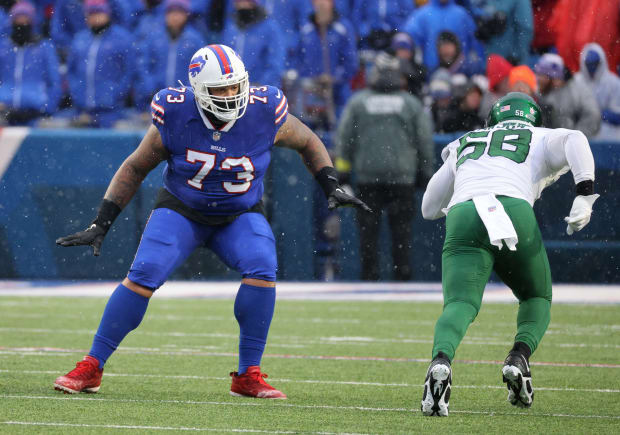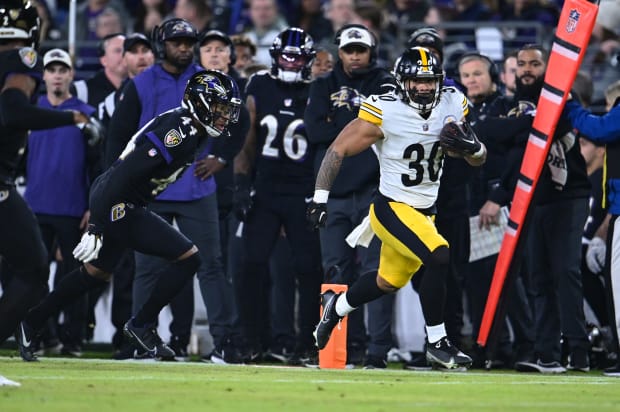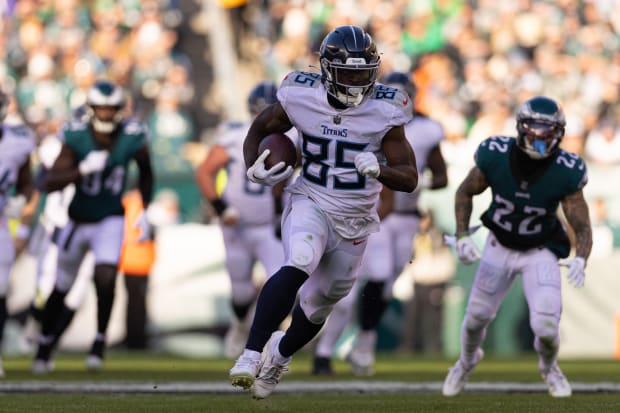This year’s All-Underrated team is back, better than ever and comprises many non-premium-position players. This isn’t a list of punt gunners, but it is a celebration of the notably unsexy. I was texting with one coach as I was putting this list together, wondering how we don’t have an adequate way to measure how well someone simply does what they’re told, and within that system developing their own kind of structured greatness that is good for the team as a whole.
There are defensive players whom we might never see near the top of the sack list who impact a game in myriad ways simply by being where they are supposed to be, or by understanding when someone else isn’t where they are supposed to be. While not every entry in this year’s list goes that deep, it was part of the consideration. So was a player’s emotional impact, mental impact and stylistic impact. Being underrated is in the eye of the beholder, and maybe this list is just my flagging my own knowledge gaps.
Either way, we should venture through it together. Even if the player isn’t underrated to you, he is to some crackpot analyst out there somewhere. And it’s always fun to say I told you so.
Below is one player on every AFC team, and we’ll be back with the NFC players Friday.

Jamie Germano/USA TODAY Network
Buffalo Bills
Dion Dawkins, offensive tackle
I still can’t believe the Bills got rid of last year’s most underrated player, wide receiver Isaiah McKenzie. McKenzie was one of the Bills’ most significant players in terms of net yards over average, a metric that shows how well the team does with a certain player on the field versus off it. He’ll be a solid addition to the Colts’ roster, even with the diminishing role kickoff returns are playing in the game. The Bills’ running game alone was a full two yards per snap better with McKenzie on the field. Anyway, I’m going with Dion Dawkins, who is a two-time Pro Bowler. You could say it’s hard to argue that a two-time Pro Bowler would be underrated, and yet, here we are. This list has Dawkins as the 21st-best tackle in the NFL. This one has him as the 31st-best offensive tackle. He did not make The MMQB’s list of the 10 best offensive linemen at the moment. Dawkins, however, is remarkably consistent. He allowed just three sacks a year ago. The Bills’ run game is 1.12 yards per carry better when he is in the lineup. And, from an emotional standpoint, I felt like Dawkins was one of the stalwarts who helped the Bills through an incredibly difficult season a year ago. Dawkins is 29 and, on a four-year contract, is making almost $10 million per season less than the top-paid tackle on the market. In plays run between the left guard and left tackle, where Dawkins plays, the Bills were ranked fifth in gap usage frequency and second in effectiveness at that gap.
Miami Dolphins
Robert Hunt, guard
The Dolphins are a powerful offensive machine full of speedy pieces that are expertly put into open space. A lot of times, to maximize performances, coach Mike McDaniel needs sound offensive line play. This was evident when the team splurged on Terron Armstead immediately upon McDaniel’s arrival. In looking at Robert Hunt, though, I think Miami has another piece to build on. Having athletic, stalwart players, especially on the interior, helps the Dolphins run most of their zone suite and also transition to their gap-scheme plays, which they run with far less frequency. Hunt, to me, has started to develop that strong first-step quickness that, on zone plays, helps to shut out a defensive tackle from giving chase and blowing up a play in the backfield. While Hunt was a guard and tackle last season, it’s worth noting that in the gap between the guard and tackle, the Dolphins were averaging 6.6 yards per carry, which was good enough for fifth in the NFL. These pivot point guards in the rapidly popularizing outside-zone scheme are getting harder to find, so developing one from scratch is a major win.
New York Jets
John Franklin-Myers, defensive end
Despite Robert Saleh’s plan to overload the defensive line, much in the way the 49ers did during his time as defensive coordinator that yielded a trip to the Super Bowl, John Franklin-Myers is going to be hard to kick out of the lineup and pigeonhole into a rotational role. The 26-year-old has been with the Jets for the last three seasons and posted what could be considered his best campaign in 2022, with a career-high 20 quarterback hits. Franklin-Myers plays the run and the pass rush equally well, and, when he was in the lineup last year, the Jets were more than one-third of a yard better against the run on a per-down basis. Franklin-Myers can rush well from multiple positions, and his powerful patience on the edge is a valuable asset against a slew of offenses built to conflict his position.
New England Patriots
Rhamondre Stevenson, running back
While I expect the Patriots’ offense to upgrade in competency this offseason, it was interesting to look back at their 2022 season with the context that they had a former defensive and special teams coordinator calling an offense that they were essentially taught before the start of the season. New England had a far less pronounced zone- and gap-run split than most teams, which I imagine would make getting into a groove difficult for a back, as the steps are different. We read a lot about the Patriots’ attempt to install more wide-zone looks during training camp. In addition, New England rarely utilizes play-action (it was 28th in the NFL in play-action usage last season, according to Sports Info Solutions data), which, I feel, presents a more vanilla (and ultimately predictable) suite of plays. Rhamondre Stevenson’s loaded box percentage (the number of times he faced eight or more defenders on a run) was not particularly high, but logging 1,040 yards and five touchdowns given all of the counterweights to his potential success were impressive. Stevenson also caught 69 balls, averaging almost seven yards after the catch per reception.
Cincinnati Bengals
Ted Karras, center
Ted Karras was not just part of a wave of upgrades the Bengals made to their offensive line; he’s an intellectual counterpart to Joe Burrow. The more responsibility that is handed over to Burrow, the more he’ll need someone like Karras to carry the load up front. Karras allowed just two sacks last year and was penalized three times total. Burrow is not going to leave the pocket frequently and still has the propensity to extend plays in the pocket. Having Karras helps in managing some of that chaos.
Cleveland Browns
Donovan Peoples-Jones, wide receiver
While writing a column wondering why the Browns hadn’t been in the mix for DeAndre Hopkins, I had a bit of an internal debate about Donovan Peoples-Jones. If the Browns were any other team, and not the kind that desperately needs to convince people that signing Deshaun Watson was a rational and defensible idea, it would make perfect sense to allow a prospect like Peoples-Jones to blossom. I used to say something similar about early-career Jarvis Landry, and it’s true of Peoples-Jones as well: Every repetition looks like a full-on battle. He is a master of contested-catch situations and while he is not going to maximize everything that occurs after the catch (perhaps that could be his evolution in 2023), there is something to be said for someone who is so doggedly dependable.
Baltimore Ravens
Tyus Bowser, outside linebacker
Tyus Bowser doesn’t necessarily pop on graded sites like Pro Football Focus, nor is a high of seven sacks in Baltimore something to write home about (until you consider the sheer depth of pass rushers the Ravens have at their disposal). Still, what’s cool about Bowser is how good of a system player he can be. The totality of his knowledge, his coverage reps, the smoothness with which he can stunt inside and create pressure; the library of smart plays that he’s made is vast. When you ask around about Bowser, the words you get are “special” and “selfless.”

Tommy Gilligan/USA TODAY Sports
Pittsburgh Steelers
Jaylen Warren, running back
Former editor and MMQB podcast head honcho Gary Gramling used to love the phrase “stylistic complement,” and it’s something I think a lot about when a team is crafting its own identity. If you are the Steelers, and the beating heart of your offense is theoretically whatever Najee Harris is providing on the ground supplemented by your brilliant young wide receivers, then it is a very good idea to have someone like Jaylen Warren. Over 77 carries last year, Warren flashed a bit of young Austin Ekeler. He is an excellent receiver out of the backfield, nabbing 28 of his 33 catch opportunities. And while Harris is clearly the better pass protector, there is a value in having a second dual-threat option out of the backfield who, at 5'8", provides a drastically different sight line for defenders. Pittsburgh’s backfield is almost like facing a baseball team that is allowed to change pitchers on a batter-to-batter basis. It wouldn’t surprise me to see Warren’s workload increase.
Indianapolis Colts
E.J. Speed, linebacker
The Colts needed all hands last year, especially with Shaq Leonard missing most of the season. E.J. Speed, a 2019 fifth-round draft pick, played everywhere for the Colts. In addition to valuable snaps on kickoff, kick return, punt and punt return, Speed played in the box, as a down lineman and as a cornerback in certain situations. He missed just three tackles, despite setting a career high with 63 for the season. While his usage may deteriorate a bit, he is a good example of the rise in baseline talent level in the NFL. Perhaps Speed can’t impact a game like Leonard, but in Leonard’s absence, he can prove to be quality depth; enough so that he earned a two-year extension at the end of last season. A defense that is unconventionally structured, as the Colts’ is, almost requires adequate depth to combat the run, especially in a division with Derrick Henry and Dameon Pierce.
Jacksonville Jaguars
Evan Engram, tight end
The Jaguars drafted a tight end, Brenton Strange, in the second round this year and are currently paying Evan Engram $11.3 million on the franchise tag. This will be interesting to watch, as Engram was critical to the opening up of Jacksonville’s offense over the second half of the 2022 season. Perhaps Doug Pederson wants to pivot toward more 12-personnel looks (a formation with two tight ends). Last year, the Jaguars used the formation more than 22 other teams in the NFL. Engram is valuable, because he’s athletic enough to come out of bunch formations as a behind-the-line receiver and pick up significant yardage. He also had the best catch percentage of his career after early in his playing days being labeled, a bit unfairly, as an unreliable target. Engram also broke more tackles and is honing his skills after the catch, which has helped the Jaguars and Trevor Lawrence own the middle of the field. This, in particular, was valuable in helping Jacksonville more dependably extend drives with high percentage throws. Engram’s 73 catches and 766 yards last year were both career highs after spending the previous five seasons on the Giants.
Houston Texans
Nico Collins, wide receiver
I was tempted to list cornerback Desmond King II, though King was already on my list in 2020 as a member of the Chargers. I hope he knows that his status as truly underrated never dies. This is like a Supreme Court appointment. The Texans have a number of new faces, especially on defense, as they try to quickly bridge the gap between painful irrelevance and competitiveness, so picking out a returning Texans player who flew under the radar was a little difficult. With Nico Collins, the ’21 third-round pick out of Michigan, I’m going on a bit of untapped potential. I thought he played well when he had someone more mobile like Tyrod Taylor to throw him open and draw away defenders. He’s made some big plays and squeezed the most out of opportunities despite being more of a downfield threat with quarterbacks who tend to throw short of the sticks.

Bill Streicher/USA TODAY Sports
Tennessee Titans
Chigoziem Okonkwo, tight end
For those who complained that the Titans have not done enough to elevate their group of playmakers, I present to you the next star tight end in the NFL, a player capable of having a George Kittle–like impact on Tennessee’s offense. We’ll learn more about Chigoziem Okonkwo with more playing time this year, and obviously a Titans fan is not going to consider him underrated given that he represents one of Tennessee’s best chances to have an efficient offense this year. Okonkwo logged almost eight yards after the catch and caught almost 70% of his passes as a rookie tight end with an unstable quarterback situation.
Denver Broncos
Patrick Surtain II, cornerback
All right, you say, this is absurd. We’ve all heard of Patrick Surtain II, a first-team All-Pro in his second season. But what about in the context that he may actually be the best cornerback in the NFL? I profiled the other candidate for that title, Sauce Gardner, back in May, but I can’t get his series of matchups against Davante Adams from this past year out of my mind. While I’d like to see Surtain without either Vic Fangio or Ejiro Evero (he legitimately began his career with the two best defensive minds in the NFL), the ball skills are something a defensive coordinator isn’t going to teach you. Surtain is elite, and he’s in a position to solidify that in 2023. With Jalen Ramsey in a bit of a torch-passing phase of his career, the mantle has cleared itself for a new No. 1. Surtain and Gardner played an almost identical man-to-zone defense ratio. Gardner is going to have to repeat, though, and show an ability to match Surtain’s consistently elevating game.
Los Angeles Chargers
Gerald Everett, tight end
I found this one to be pretty difficult, especially when poring over the defensive numbers to try to find a diamond in the rough. With Gerald Everett, the numbers are pretty clear: The running game, which was the engine of Los Angeles’s offense under Joe Lombardi, was markedly better (almost one-third of a yard per rush better) with Everett in the lineup. The passing game was also more than one-third of a yard better when Everett was in the lineup. He accounted for almost 10% of Justin Herbert’s total passing first downs and at times during the year it was obvious how diverse his route tree was. I think that’s what people are missing when they consider Everett as a total package; he’s got a lot of athleticism and can handle faster linebackers, and he’s also got enough tracking ability to handle some of the more difficult stuff. Everett was rarely used out of the backfield, even though I think he would be a monster on more backfield screens. He and Travis Kelce had nearly identical yards after the catch numbers in 2022.
Kansas City Chiefs
Justin Watson, wide receiver
Only two Chiefs wide receivers played more snaps than Justin Watson last year. Some people may call this evidence of an underwhelming receiving corps, but I strongly disagree. I think Kansas City’s receiving corps is full of stylistic complements; all different body types and expertises that help Andy Reid manipulate the offense however he sees fit. Watson plays a part in that. He is also a great space creator, a player who seems to understand the offense well and can run routes in a way that clears out space or moves certain defenders. Back in Week 12, for example, he was matched up pretty frequently on Jalen Ramsey early in the game and would keep him isolated on one side of the field.
Las Vegas Raiders
Jakob Johnson, fullback
Jakob Johnson, an MMQB favorite, continues the Josh McDaniels tradition of active fullbacks with a critical role in the offense. The Raiders utilized two-back sets more than almost any team in football a year ago, according to Sports Info Solutions. The Raiders were 0.12 yards per rush better with Johnson on the field. His presence was especially valuable for someone like Josh Jacobs, a back who doesn’t shy away from contact and is prone to taking on a lot of hits. NFL GSIS statistics show that Las Vegas was almost 125 total rushing yards better with Johnson on the field.
Editors’ note, June 22 at 9:00 a.m. ET: An earlier version of this story misstated Dion Dawkins’s age. He is 29, not 26.







